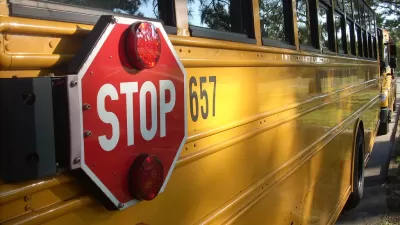Emily Badger examines the role of housing segregation in obstructing the promise of Brown v. Board of Education.
"It’s that much harder to integrate classrooms when the communities where children live are still so segregated," writes Emily Badger of the incomplete legacy of Brown v. Board of Education. Making the task of segregating public schools so difficult is the fact that of all the populations in the country, children are the most likely to be isolated from other racial or economic groups: "Since the Civil Rights Era, residential racial segregation across the U.S. has steadily declined. But segregation among school-aged children has startlingly lagged behind this progress. In the communities where they live, black and white children -- as well as the poor and non-poor -- are more isolated from each other than adults in the U.S. population at large."
The connections between housing policy and education policy lead Badger to ask the questions: "What if we made a more concerted effort to integrate schools by integrating neighborhoods? What if we tried to improve the educational prospects of low-income minority students by breaking down barriers to affordable housing in the communities where good schools exist? What if we wielded zoning laws and housing vouchers as levers of education policy?"
The article includes analysis of a number of policy examples that address these questions, including inclusionary zoning, excluding federal funding to communities that adopt exclusionary zoning standards. On the former point, Badger details a study by Heather Schwartz finding better test scores for low-income students that attended high quality schools due to an inclusionary zoning program in Montgomery County, Maryland.
FULL STORY: Housing segregation is holding back the promise of Brown v. Board of Education

Alabama: Trump Terminates Settlements for Black Communities Harmed By Raw Sewage
Trump deemed the landmark civil rights agreement “illegal DEI and environmental justice policy.”

Study: Maui’s Plan to Convert Vacation Rentals to Long-Term Housing Could Cause Nearly $1 Billion Economic Loss
The plan would reduce visitor accommodation by 25% resulting in 1,900 jobs lost.

Planetizen Federal Action Tracker
A weekly monitor of how Trump’s orders and actions are impacting planners and planning in America.

Waymo Gets Permission to Map SF’s Market Street
If allowed to operate on the traffic-restricted street, Waymo’s autonomous taxis would have a leg up over ride-hailing competitors — and counter the city’s efforts to grow bike and pedestrian on the thoroughfare.

Parklet Symposium Highlights the Success of Shared Spaces
Parklets got a boost during the Covid-19 pandemic, when the concept was translated to outdoor dining programs that offered restaurants a lifeline during the shutdown.

Federal Homelessness Agency Places Entire Staff on Leave
The U.S. Interagency Council on Homelessness is the only federal agency dedicated to preventing and ending homelessness.
Urban Design for Planners 1: Software Tools
This six-course series explores essential urban design concepts using open source software and equips planners with the tools they need to participate fully in the urban design process.
Planning for Universal Design
Learn the tools for implementing Universal Design in planning regulations.
Caltrans
Smith Gee Studio
Institute for Housing and Urban Development Studies (IHS)
City of Grandview
Harvard GSD Executive Education
Toledo-Lucas County Plan Commissions
Salt Lake City
NYU Wagner Graduate School of Public Service





























